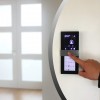To wire or not to wire?

More and more building owners, whether residential or commercial, are looking at installing building automation systems into their property. There are some many cool and useful features in modern automation systems that are now attracting much more than the initial early adopters. And the return on investment of such systems is often quite appealing. But far too many are abandoning this project when they realise the hassle and cost of passing wire throughout the building to connect the various components of the automation system. Yet, there is a simple solution: using wireless technology to interconnect all the components to circumvent the need for wires.
To wire
When you think of it, passing wires in a building can have many disadvantages:
- Drilling holes resulting in need for plastering and painting (not forgetting the resulting paint fumes and VOCs)
- Lengthy process which may disturb the occupants and result in downtime for businesses
- Can be expensive since electrician hourly rates are not cheap these days
- May not always be possible because of architectural constraints
- Less flexibility – once you passed a wire to a sensor for example, you can’t later decide to change the sensors location easily
For these reasons and others, most people are now opting to use wireless technology for building automation.
Going wireless
Wireless technology is now part of our daily lives: we use it to talk over our mobile phones, to listen to the radio, as a navigation tool with our car GPS, at home or work to surf the web over WiFi, stream video to our wireless TV or streaming video from our wireless video surveillance camera and more. In fact, most new alarm systems installed today use wireless sensors (door contacts, motion, smoke detector) to ensure a fast and cost-effective installation. If we trust wireless technologies for all of these other uses, why not for building automation?
The various options
Many options exist for building automation, which may be a bit daunting at first to the neophyte. Let’s review the various components of a typical building automation system:
a) the front-end: this is usually the brains of your system and can be running on a sophisticated server in large building or a simple gateway/router box in residential installations. In most modern systems, the front end is connected to the Internet and cloud services allowing you to control/monitor your property remotely. And wireless enabled front-ends will act as a gateway to communicate with the rest of the components in the building.
b) the controllers and thermostats: in larger commercial buildings, connected thermostats and controllers are required to locally manage HVAC and lighting equipment in various zones. In residential buildings, controllers are usually not required and a connected thermostat is the norm.
c) the sensors and actuators: sensors allow the system to monitor certain items (motion, temperature, light levels, etc) and report them back to the front-end. Actuators are motors that will move or control a simple system like opening up a water valve on a radiator or turning on the light
All of these components need to be equipped with a small radio chip to allow wireless communications between them. The available technologies and protocols behind the radio chip are numerous, but can be summarized into two basic categories:
- Powered Wireless (usually batteries for the sensors/actuators; e.g. ZigBee, Z-Wave and WiFi)
- Self-powering wireless devices (EnOcean)
Powered wireless devices
We just agreed that passing wires to interconnect the sensors/actuators/controllers to the front-end was inefficient. But what about bringing power to them. Of course, the front-end and some controllers will always need to be plugged-in. But we can also limit the amount of wires for powering most sensors and actuators. In powered wireless systems, the sensors and actuators will be powered with a battery. An option for small buildings, but a logistical nightmare in larger buildings where staff would be running around changing batteries on a regular basis. Not forgetting that batteries are expensive over time and a threat to the environment.
Self-powered wireless devices
In this type of system, sensors and actuators actually self-harvest the energy they need to function properly, making them battery-less. This is where it gets really interesting; the devices utilize energy harvesting technology to draw energy from their surroundings – for example from motion, light or temperature differences. A few examples:
- Temperature sensor or motion sensor that harvest power using a small photo-cell
- A switch that transfer the mechanical force when pressed into enough energy to transmit a on/off/dimming command
Such battery-less devices may be a bit more expensive initially than battery-powered devices, but in the long run they will actually be more economical for your wallet and a much more sustainable choice for our planet. The reference in wireless self-harvesting technology is called EnOcean.
Go wireless and battery-less
Next time you consider installing a building automation system in your home or one of the buildings you manage, make sure you evaluate all of the hidden costs and hassles of passing wires and look into going wireless instead. And when you do, consider carefully if battery-less devices are more appropriate for your property.




